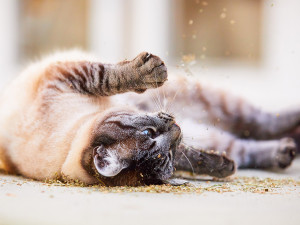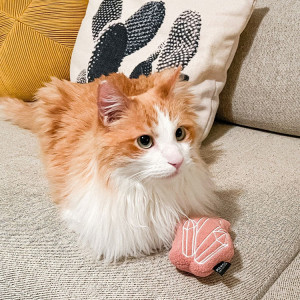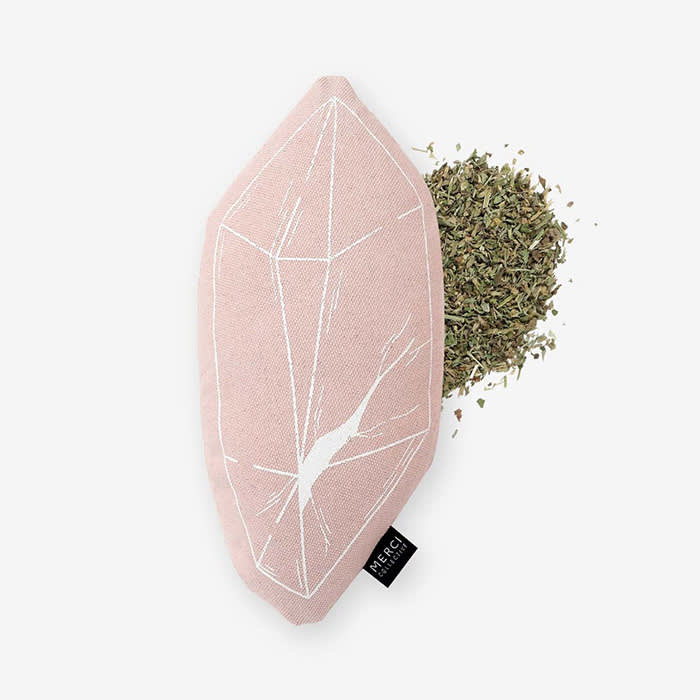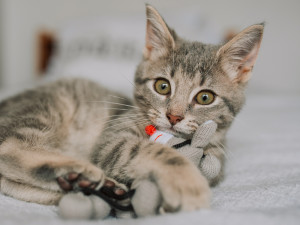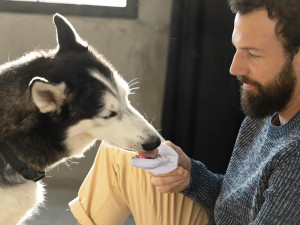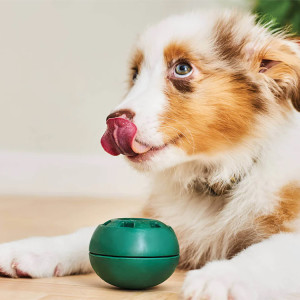Catnip for Dogs: Is it Safe?
In fact, it chills them out.
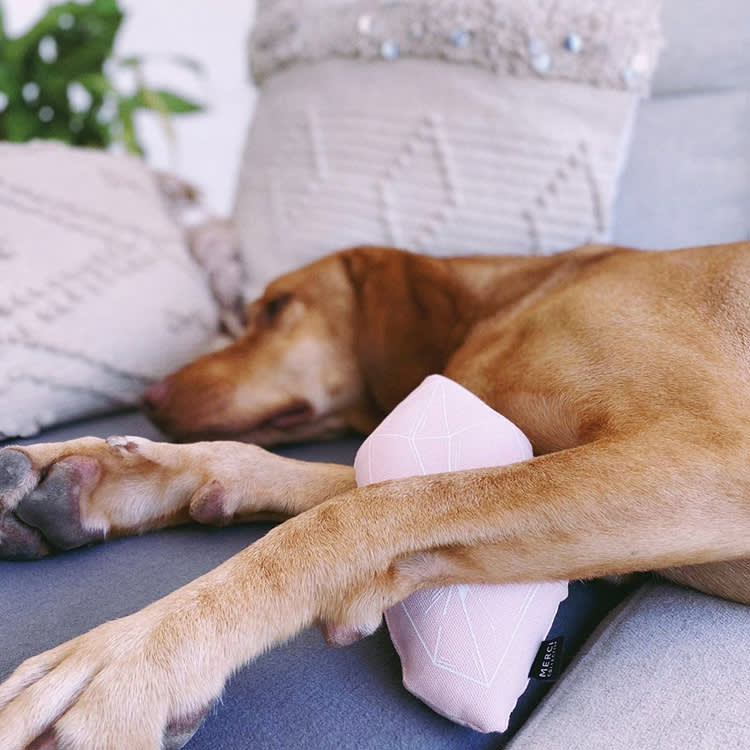
Share Article
Your cat loves catnip. You love to see your cat go absolutely bonkers for the stuff. (They probably don’t know that you give it to them just so you can watch them roll around on their back with a dazed look on their face). For the dog people who think that sounds like a great way to spend a Saturday — 4/20 or notopens in new tab — there’s good news: Your dog can love and benefit from catnip just as much as cats. While pups don’t experience the same energizing effect as blissed-out kitties, catnip may help your dog relax, wind down, and recover from stressful experiences.
Before going catnip wild with your pups, we suggest familiarizing yourself with the specific reactions they may have, potential contraindications, and recommended dosage. TL;DR: Some dogs can enjoy the wonder of catnip in appropriate quantities for a chillaxed good time.
Main takeaways:
Catnip is safe for dogs and can have a calming effect — the opposite of what’s seen in cats.
Catnip has been used for its health benefits in humans, but these benefits have not been studied or proven in dogs.
A little goes a long way; start your dog on small amounts.
Check with your vet before giving catnip if your dog is taking a prescription sedative, anti-anxiety, or anti-seizure medications.
Talk to your vet about and be cautious with catnip essential oil, which can cause gastrointestinal upset and skin irritation.
What is catnip?
Nepeta cataria is an aromatic perennial herb that is also called “catnip” or “catmint.” The plant gets its nicknames because of the effect it has on cats when they sniff, bite, or chew it. It also attracts pollinators like butterflies and bees. Catnip is native to Europe and Asia and has become a common ornamental plant for homes in North America. Before the development of many modern medications, Nepeta cataria was used to make juices, teas, and tinctures for human consumption. Nepetalactone is the substance in catnip that induces the euphoric response in cats.
Is catnip safe for dogs?
According to veterinarian and Kinship Collective member Dr. Lindsey Wendt, catnip is as safe for dogs as it is for felines. There have yet to be any studies revealing health benefits specifically in dogs, but broader investigations have shown that catnip can have anti-inflammatory properties; help get rid of microbes, bacteria, and parasites; and protect the liver in certain cases of drug-related injury. Catnip essential oilopens in new tab has been shown to repel 13 families of insects, in some cases 10 times better than DEET.

Health benefits of catnip
Catnip has been used to help with human ailments for ages, but it’s not clear if all (or any) or these benefits translate to dogs. Some possible health benefits of catnip include:
Anxiety relief
Catnip can make cats excited and active, but may have a mild sedative effect in some dogs. Catnip tea has been used for its calming effect on people. Catnip’s potential calming effect on dogs has not been studied or proven, but there are anecdotal reports of its calming effect.
Better sleep
The nepetalactones in catnip are similar to valepotriates, which are the compounds found in valerian root. Valerian root has been used to help some dogs with mild anxiety. Some people take valerian root to help treat their insomnia, but it's unknown if any drowsiness can be expected in dogs.
Stomach soothing
In the past, catnip has been used as a remedy for gastrointestinal issues in people. It was used to calm intestinal spasms, which could provide relief from diarrhea, cramping, and gas. Because catnip contains essential oils, dogs may experience the opposite effect and develop loose stool or other GI signs if they ingest too much.
Help with healing
One studyopens in new tab showed that essential oils from catnip had an antimicrobial effect against multiple bacteria commonly found in canine skin infections. Other studies found that extracts from Nepeta deflersiana, a species closely related to Nepeta cataria, was shown to weaken cancer cells.
Natural pest repellant
Essential oils and nepetalactones from catnip have been shown to repel mosquitoesopens in new tab with the same (or higher) efficacy as DEET, depending on the concentration used.
How might catnip affect dog behavior?
Dogs experience the effects of catnip differently than cats do. Chani Ronez, founder of Merci Collectiveopens in new tab, explains that their reactions are often nearly opposites. “Catnip is an herb from the mint family that cats are particularly sensitive to,” she says. “When cats are exposed to catnip, it causes them to become more active and playful and leads them to a feeling of pure bliss and euphoria. For dogs, however, it’s totally different in that it offers a sense of relaxation and calm.”
In general, you can expect to see these results in 30 to 60 minutes. So, if there are particular situations you want to support your dog through with catnip, such as relieving anxietyopens in new tab at the vet, this time frame is helpful to keep in mind.
Should you give catnip to your dog?
Catnip hasn’t been proven to have significant benefits in dogs, but giving them a taste shouldn’t cause any harm. You may not see any difference in your dog’s demeanor. If it makes your dog chill out a bit — that’s a bonus.
Despite catnip’s uses in human health, catnip should only be used as a supplement. Though it may be helpful in certain situations, catnip should not be given to dogs as a replacement for vet-prescribed sedatives, antibiotics for skin infections, or heartworm prevention.
How should I give catnip to my dog?
Dr. Wendt adds that it’s important to start nice and slow. You want to be able to see how your individual dog responds to catnip and determine whether it is a good option for them. If you start with a small amount and your dog really likes it, you can consider increasing the amount slowly using the following guidelines:
1/8 tablespoon for small-breed dogs
1/4 tablespoon for medium-sized dogs
1/2 tablespoon for large dogs
“A little goes a long way!” Dr. Wendt says. “More is not necessarily better — consider offering it a few times a week rather than on a daily basis.”
There are lots of ways to integrate catnip into your pup’s routine. Dr. Wendt recommends sprinkling some into a snuffle mat or another engaging toy that encourages foraging. “Scentwork is a great option for dogs with mobility issues, as cognitive stimulation is just as important as physical,” she says.
Dr. Wendt cautions that you shouldn’t give your dog a toy that is made for cats — this is more likely to lead to a situation of excessive exposure and toxicity, as well as potential foreign body ingestion. Merci Collective’s Chouchouopens in new tab is a catnip-filled chew toy made for anxious pups and one of the only dog-specific catnip toys on the market.
“We were very mindful of what materials we used in designing the Chouchou,” Chani says. “We went with a heavyweight canvas that is made of 100 percent cotton to ensure it’s strong, natural, and free of chemicals and harsh dyes. We use an eco-friendly stuffing that is hypoallergenic and made of recycled materials.” She adds, “Our catnip is super strong, grown in North America, and free of pesticides, and the toy is printed, cut, stuffed, and assembled in Los Angeles.”
Dr. Wendt also recommends Rx Vitamins Nutricalm for dogs and Real Mushrooms Relax Pet Chewsopens in new tab.
What potential risks or other concerns should I know about before giving catnip to my dog?
If your dog is already taking a prescription sedative, anti-anxiety, or anti-seizure medications, be sure to check with your veterinarian before giving them catnip. Dr. Wendt says you should avoid using catnip essential oil without the direction of a veterinarian; it can cause skin irritation and is more likely to cause toxicity.
She warns that catnip is like any herb or supplement and can be harmful if ingested in excessive quantities. But keeping portions incremental and appropriate for your dog’s size should be completely safe. Soon, your best pal (and you, as a result) will be chillin’ more than ever.
Final thoughts: Is catnip safe for dogs?
Catnip is safe for dogs and may have a soothing effect that can help ease some dogs’ anxiety. Some dogs won’t experience any change in behavior, though. If you want to give your dog catnip, start with a small amount and see how they tolerate it. Talk to your vet first if your dog is already on sedatives or seizure medications.
FAQs
Does catnip affect dogs and cats the same?
Catnip tends to have the opposite effect in catsopens in new tab versus dogs. Cats will experience excitement and euphoria, while dogs may experience mild sedation.
Do vets recommend catnip for dogs?
Catnip can be used to take the edge off and reduce mild anxiety in some dogs. But if your dog is experiencing severe anxiety, your vet will recommend something stronger and more reliable.
How much catnip do you give a dog?
When giving your dog catnip, start with a small amount. Give your dog 1/8 (small dog) to 1/2 tablespoon (large dog) and monitor to see how they tolerate it.
References
“Nepeta Cataria (Catmint, Catnip, Catswort) | North Carolina Extension Gardener Plant Toolbox.” Plants.ces.ncsu.edu, plants.ces.ncsu.edu/plants/nepeta-cataria/opens in new tab.
Grognet J. Catnip: Its uses and effects, past and present. Can Vet J. 1990 Jun;31(6):455-6. PMID: 17423611; PMCID: PMC1480656. https://pmc.ncbi.nlm.nih.gov/articles/PMC1480656/opens in new tab
Glenn Neville Borlace, et al. “Antimicrobial Effects of Catnip (Nepeta Cataria L.) Essential Oil against Canine Skin Infection Pathogens.” Veterinary World/Veterinary World, 1 Mar. 2024, pp. 585–592, www.ncbi.nlm.nih.gov/pmc/articles/PMC11045539/opens in new tab, https://doi.org/10.14202/vetworld.2024.585-592. Accessed 2 June 2024.
“Catnip | Michigan Medicine.” Www.uofmhealth.org, www.uofmhealth.org/health-library/hn-2063002opens in new tab.
Taylor, Sienna, and Joah Madden. “The Effect of Pet Remedy on the Behaviour of the Domestic Dog (Canis Familiaris).” Animals, vol. 6, no. 11, 25 Oct. 2016, p. 64, https://doi.org/10.3390/ani6110064opens in new tab.

Maia Welbel
Maia is a freelance writer, editor, and researcher based in the Bay Area. She aims to help readers imagine and engender ecologically resilient futures for all living beings. Outside of work, she loves dancing, hiking, and baking. She also volunteers weekly at an equine therapy barn. Her work has appeared in Cherry Bombe, Chickpea, In These Times, i-D, and more.

Dr. Alycia Washington, DVM, MS
Alycia Washington is a small-animal emergency veterinarian with over 10 years of experience based in North Carolina. She works as a relief veterinarianopens in new tab and provides services to numerous emergency and specialty hospitals. She also works as a veterinary writer with a focus on educating pet parents.
Related articles
![Small gray tabby kitten playing with a toy]()
The Best Catnip Toys and Treats That’ll Have Your Cat Riding High
Let the purring, drooling, and chasing invisible butterflies commence.
![Cat sitting on a window sill eating cat grass]()
Sweet Greens: The Best Cat Grass Grow Kits
Not to be confused with catnip (or other buds).
![Close-up of a Merle coated Greyhound dog laying in the lap of their pet parent on the bed]()
How to Give Relief to Your Dog With a Chronic Condition
What are the best ways to manage a dog’s pain?
![A white fluffy dog laying on a white surface next to a retro red colored TV and a bag of Dad Grass dog treats with some bone-shaped treats on the ground near the dog]()
Dad Grass is Helping Dogs Light Up
With a new line of CBD-infused bones and pack-shaped plush toys, pups can munch to mellow out.
![A bearded man in a gray sweater and yellow pants sitting on the floor and holding a Groov Training Aid in "lilac" from Diggs Pet, which is like a grooved plastic popsicle with treats smeared in, while his Husky dog licks it]()
9 Stress Toys For Dogs That Are Cheaper Than Therapy
The toys that’ll help your pup chill out after a long day of being a dog.
![Mini shepherd laying on ground licking pupsicle toy]()
The Pupsicle Will Soothe Puppies Who Need to (Literally) Chill
Woof’s innovative fillable design will help dogs de-stress and their parents save money.

